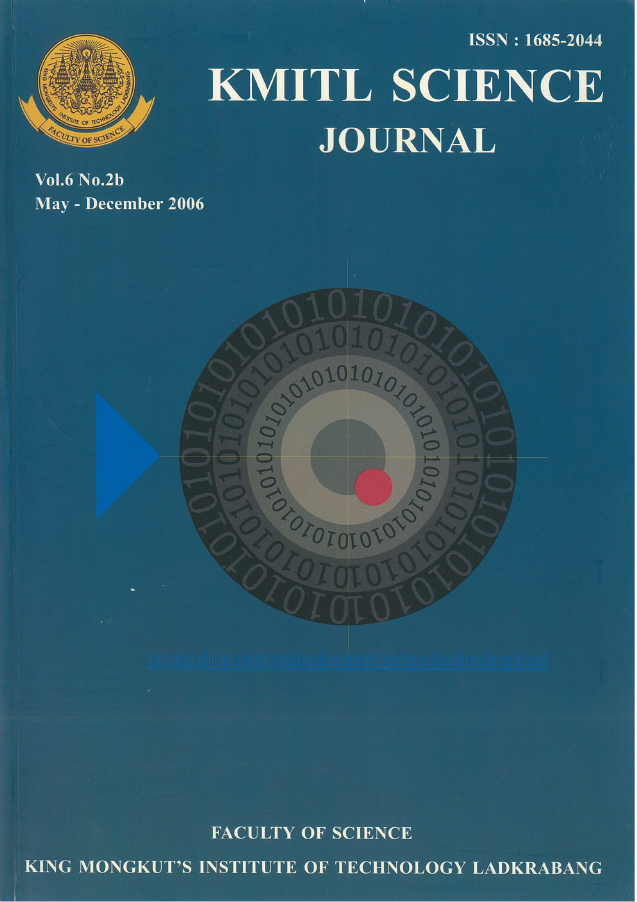Appropiate Composition of Power Plant Wastes for Preparation of Fired Planting Materials
Main Article Content
Abstract
Fired planting materials is presently very popular, because it has the special characteristics of light weight, low density and can be reused. Preparation of fired planting materials from bottom ash, flue gas desulfurization (FGD) gypsum which are residues from Mae Moh power plant in Lampang province mixed with paddy clay and sawdust was studied. Various formulae of planting materials were prepared by different ratios between bottom ash, FGD gypsum and paddy clay with different compositions of sawdust added, and different temperature of oxidation firing at 600, 700, 800 and 850˚C. It can be concluded that the appropriate composition for planting material is 22% of bottom ash, 7% of FGD gypsum and 45% of paddy clay with 26% of sawdust added. The best oxidation firing must be at least 850˚C for 30 minutes, with increasing rate of 3˚C/minute from room temperature. This planting material was not slake when soaked in water. It has 50% water absorption, pH 6.43, density 1.21 g/cm3 and cation exchange capacity 8.9 meq/100g. It is shown that this produced planting material has high water absorption, slightly acidic pH value, light weight and rather high cation exchange capacity. Furthermore, this planting material has good characteristic from high quality unslaking which resulted from soaking it in water for 30 days.
Keywords: Bottom ash, FGD gypsum, Paddy clay, Sawdust, Cation exchange capacity, Planting material, Bulk density, Water absorption
Corresponding Author Email: orpanyo@chiangmai.ac.th
Article Details
Copyright Transfer Statement
The copyright of this article is transferred to Current Applied Science and Technology journal with effect if and when the article is accepted for publication. The copyright transfer covers the exclusive right to reproduce and distribute the article, including reprints, translations, photographic reproductions, electronic form (offline, online) or any other reproductions of similar nature.
The author warrants that this contribution is original and that he/she has full power to make this grant. The author signs for and accepts responsibility for releasing this material on behalf of any and all co-authors.
Here is the link for download: Copyright transfer form.pdf
References
[2] Korcak, R. F., 1995. Utilization of coal combustion by-products in agriculture and horticulture, American Society of Agronomy, WI, USA, 58, pp.107-130.
[3] Mukhtar, S., Kenimer, A. L., Sadaka, S. S. and Mathis, J. G., 2003. Evaluation of bottom ash and composted manue bends as a soil amendment material, Bioresource Technology, 89(3), 217-228.
[4] Sell, N. and McIntosh, T., 1989. The agronomic landspreading of coal bottom ash: Using a regulated solid waste as a resource, Resource, Conservation and Recycling, 2(2), 119-129.
[5] Sakai, Y., Matsumoto, S. and Sadakata, M., 2004. Alkali soil reclamation with flue gas desulfurization gypsum in China and assessment of metal content in corn grains, Journal of Soil Contamination, 13 (1), 65-80.
[6] Alva, A. K., 1994. Possible utilization of flue-gas desulfurization gypsum and fly ash for citrus production: Evaluation of crop growth response, Waste management, 14 (7), 621-627.
[7] Dick, W. A., Chen, L. and Welson, S., 2001. Flue gas desulfurization by-products additives to acid soil: alfalfa productivity and environmental quality. Environmental Pollution, 114 (2), 161-168.
[8] Perez-Murcia, M.D., Moral, R., Moreno-Caselles, J., Perez-Espinosa, A. and Parades, C., 2006. Use of composted sewage sludge in growth media for broccoli. Bioresource Technology, 97(1), 123-130.
[9] http://aggie-horticulture.tamu.edu/greenhouse/nursery/guides/green/media.html
[10] http://www.hdra.org.uk/guidelines/materials_media.htm
[11] http://searcher.uaex.edu/compass?ui=sr&scope=growing+media+for+container
[12] Urrestarazu, M., Martínez, G. A. and Salas, M.C., 2005. Almond shell waste: possible local rockwoolsubstitute in soiless crop culture. Scientia Horticulturae, 103(4), 453-460.
[13] Benito, M., Masaguer, A., DE-Antonio, R. and Moliner, A., 2005. Use of pruning waste compost as a component in soiless growing media. Bioresource Technology, 96 (5), 597-603.
[14] Hernándaz-Apaolaza, L., Gascő, J. M. and Guerrero, F., 2005. Reuse of waste materials as growing media for ornamental plants. Bioresource Technology, 96(1), 125-131.
[15] Metson, A. J., 1971. Methods of chemical analysis for soil surway samples. Crown, Wellington, pp. 81-110.
[16] http://www.uaex.edu/Other_Areas/publications/PDF/FSA-6098.pdf
[17] Jone, J. B., 1997. Hydrophonics: A practical guide for soiless grower: Florida, St.Lucie Press. Boca Raton, pp. 75-95.
[18] Leeper, G. W., 1972. Storehouse for plants: The Chemistry of the Soil. Malborne, Thomas Nelson. Pp. 1-2.


